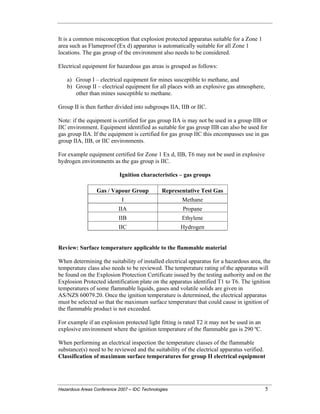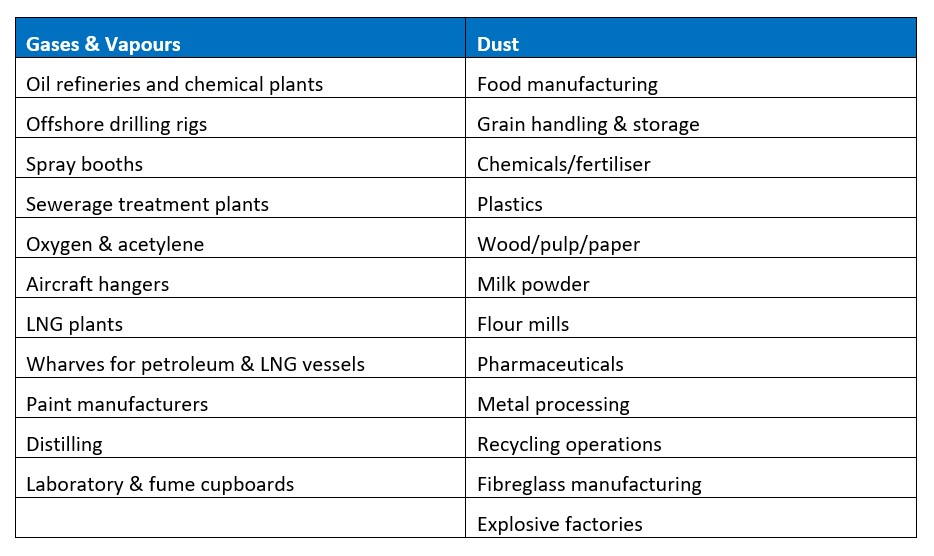The Ultimate Guide To Roar Solutions
The Ultimate Guide To Roar Solutions
Blog Article
What Does Roar Solutions Mean?
Table of ContentsThe Buzz on Roar SolutionsFacts About Roar Solutions RevealedThe Definitive Guide for Roar Solutions
In such an ambience a fire or surge is feasible when 3 basic conditions are met. This is often referred to as the "hazardous location" or "burning" triangle. In order to shield installments from a prospective explosion an approach of analysing and identifying a potentially unsafe location is called for. The objective of this is to make sure the proper option and installment of devices to eventually avoid a surge and to guarantee security of life.
(https://www.anyflip.com/homepage/vpiyp#About)
No tools needs to be installed where the surface area temperature level of the tools is higher than the ignition temperature of the provided hazard. Below are some common dirt unsafe and their minimal ignition temperature. Coal Dust 380C 225C Polythene 420C (thaws) Methyl Cellulose 420C 320C Starch 460C 435C Flour 490C 340C Sugar 490C 460C Grain Dust 510C 300C Phenolic Material 530C > 450C Aluminium 590C > 450C PVC 700C > 450C Soot 810C 570C The possibility of the hazard being present in a focus high adequate to create an ignition will vary from location to area.
Dangerous area electrical tools possibly created for usage in higher ambient temperature levels. Area Repair Service By Authorised Worker: Complex testing might not be called for nonetheless certain procedures may need to be followed in order for the devices to preserve its 3rd event rating. Each item of equipment with a dangerous score need to be reviewed separately.
The Basic Principles Of Roar Solutions
The tools register is a comprehensive data source of tools documents that includes a minimum collection of fields to determine each product's location, technical specifications, Ex category, age, and ecological data. This details is important for tracking and handling the equipment properly within dangerous locations. In comparison, for periodic or RBI tasting inspections, the grade will be a combination of In-depth and Close inspections. The ratio of In-depth to Shut inspections will certainly be identified by the Tools Threat, which is assessed based upon ignition threat (the possibility of a source of ignition versus the probability of a combustible ambience )and the unsafe area classification
( Zone 0, 1, or 2). This variation will also influence the resourcing requirements for work prep work. As soon as Lots are defined, you can establish tasting strategies based upon the sample size of each Lot, which refers to the variety of random equipment products to be checked. To figure out the needed example size, 2 aspects require to be assessed: the dimension of the Great deal and the classification of examination, which suggests the degree of effort that ought to be applied( minimized, typical, or boosted )to the assessment of the Great deal. By incorporating the category of assessment with the Great deal size, you can then establish the proper rejection requirements for a sample, suggesting the allowed variety of damaged things discovered within that example. For even more details on this process, please describe the Energy Institute Standards. The IEC 60079 basic advises that the maximum interval between evaluations ought to not go beyond three years. EEHA assessments will certainly also be performed beyond RBI projects as part of arranged maintenance and equipment overhauls or fixings. These assessments can be credited towards the RBI sample dimensions within the influenced Whole lots. EEHA evaluations are performed to determine mistakes in electric devices. A weighted scoring system is necessary, as a single piece of devices might have multiple mistakes, each with differing levels of ignition threat. If the combined rating of both evaluations is much less than two times the fault score, the Lot is considered acceptable. If the Great deal is still considered unacceptable, it has to undertake a full examination or reason, which might set off stricter assessment protocols. Accepted Whole lot: The sources of any type of mistakes are recognized. If an usual failing setting is discovered, extra tools might call for maintenance. Faults are categorized by extent( Safety and security, Integrity, Home cleaning ), making sure that immediate problems are examined and attended to quickly to mitigate any kind of effect on safety or procedures. The EEHA database ought to track and record the lifecycle of mistakes along with the corrective activities taken. Applying a robust Risk-Based Inspection( RBI )strategy is important for making certain compliance and security in taking care of Electric Devices in Hazardous Locations( EEHA) (eeha certificate). Automated Mistake Scoring and Lifecycle Monitoring: Effortlessly handle mistakes and track their lifecycle to boost examination precision. The introduction of this assistance for risk-based examination further enhances Inspectivity's position as a best-in-class solution for governing conformity, in addition to for any asset-centric evaluation use case. If you are interested in learning much more, we welcome you to request a demo and uncover just how our solution can change your EEHA management procedures.
Excitement About Roar Solutions

In terms of eruptive risk, a hazardous area is a setting in which an explosive ambience exists (or might be anticipated to be present) in quantities that call for special precautions for the construction, setup and usage of tools. high voltage courses. In this article we check out the challenges faced in the work environment, the threat control actions, and the called for expertises to function safely
It is an effect of modern-day life that we make, store or take care of an array of gases or fluids that are considered flammable, and a range of dusts that are deemed combustible. These materials can, in particular conditions, develop eruptive environments and these can have significant and tragic repercussions. Most of us recognize with the fire triangle eliminate any among the three elements and the fire can not take place, yet what does this mean in the context of dangerous locations? When damaging this down right into its simplest terms it is essentially: a combination of a certain amount of release or leakage of a particular material or material, combining with ambient oxygen, and the presence of a resource of ignition.
In a lot of circumstances, we can do little about the levels of oxygen airborne, but we can have significant influence on resources of ignition, for instance electrical tools. Harmful locations are recorded on the dangerous location category drawing and are identified on-site by the triangular "EX LOVER" indicator. Below, among other key info, zones are divided into three kinds depending on the danger, the possibility and duration that an eruptive atmosphere will exist; Zone 0 or 20 is regarded the most harmful and Zone 2 or 22 is considered the least.
Report this page